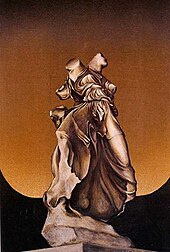Modern Greek art

Modern Greek art is art from the period between the emergence of the new independent Greek state and the 20th century. As Mainland Greece was under
The Cretan School and in particular the Heptanese School of art are two important artistic movements in Greece that followed parallel routes to Western Europe.[1]
Modern Greek art can be said to have been predominantly shaped by the particular socioeconomic conditions of Greece, the large Greek diaspora across Europe, and the new Greek social elite, as well as external artistic influences, predominantly from Germany and France.
Sculpture and painting
19th century
The School of Munich


Modern Greek art began to be developed around the time of Romanticism. Greek artists absorbed many elements from their European colleagues, resulting in the culmination of the distinctive style of Greek Romantic art, inspired by revolutionary ideals as well as the country's geography and history. After centuries of Ottoman rule, few opportunities for an education in the arts existed in the newly independent Greece, so studying abroad was imperative for artists. Munich, as an important international center for the arts at that time, was the place where the majority of the Greek artists of the 19th century chose to study. In the school of Munich, led by Karl von Piloty, true fresco was taught for mural paintings on fresh wet lime plaster. During this period much of the art was emotional and theatrical in tone. The most prominent themes of the school of Munich were urban life, rural life, still life, and landscape.[1]
Later on, they would return to Greece and pass on their knowledge. Some of them remained in Munich, the so-called Athens on the
Other artists associated with the
Notable sculptors of the new
The School of Paris

A few Greek painters studied in
Themes-artistic depictions
Many Greek artists of this period also drew upon
20th century

At the beginning of the 20th century landscape painting held sway and the interest of painters turned toward the study of light and color.
Gradually the
Notable 20th- and 21st-century artists
The second half of the 20th century has seen a range of acclaimed Greek artists, such as
Gallery
-
Konstantinos Volanakis, Anchored boats.
-
Ioannis Altamouras, The port of Copenhagen.
-
Kolokotronis' statue by Lazaros Sochos.
-
Grandma's Favorite by Georgios Jakobides.
-
Capuchin friar by Nikolaos Gyzis.
-
Theofilos Hatzimichail, Symposium of Empress Eudoxia.
-
Theodoros Vryzakis, The sortie of Messologhi.
-
Statue of Socrates by Leonidas Drosis.
-
Theodore Ralli, Eavesdropping.
-
Nikiphoros Lytras, Antigone in front of the dead Polynices.
-
Nikolaos Lytras, The straw-hat.
-
The "umbrellas" of Zongolopoulos in Thessaloniki.
See also
| Part of a series on the |
| History of Greek art |
|---|
 |
- Culture of Greece
- Modern Greek architecture
- Mycenaean Revival architecture
- National Gallery of Athens
References
"Characteristics of Romanticism"[2]. www.bluffton.edu. Retrieved 2022-04-26.[6]
"The so-called Munich School, and the Greek painting of the 19th century".[3] USEUM. Retrieved 2022-04-26.[7]
"5 Greek Female Artists You Should Know".[4] DailyArt Magazine. 2020-07-08. Retrieved 2022-04-26.[8]
References
- ^ Nano Chatzidakis, in From Byzantium to El Greco, p.49, Athens 1987, Byzantine Museum of Arts
- ^ a b "Greek Artists at the Academy of Munich, 19th - 20th century". Archived from the original on 2007-08-05. Retrieved 2007-07-29.
- ^ a b "Archived copy" (PDF). Archived from the original (PDF) on 2011-06-06. Retrieved 2007-02-06.
{{cite web}}: CS1 maint: archived copy as title (link) - ^ Modern and Contemporary Art in Greece (1984), Hans-Jörg Heusser AICARC Center, Zürich
- ^ Greek Horizons: Contemporary Art from Greece (1998), Efi Strousa, Roger Wollen, Tullie House Museum, Art Gallery Carlise, England
- ^ "Characteristics of Romanticism". www.bluffton.edu. Retrieved 2022-04-26.
- ^ "The so-called Munich School, and the Greek painting of the 19th century". USEUM. Retrieved 2022-04-26.
- ^ "5 Greek Female Artists You Should Know". DailyArt Magazine. 2020-07-08. Retrieved 2022-04-26.













